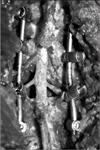Abstract
Lumbosacral fracture-dislocation is very rare because of the characteristic anatomical features, and various displacements by injury mechanisms have been reported. Most of the reports were displaced by flexion, distraction, compression and rotation. Complete reduction and appropriate treatment can be difficult or impossible in the case of delayed diagnosis. We report a case of lumbosacral fracture & dislocation that occured in horizontal shear and flexion, which was correctly diagnosed and treated successfully with partial corpectomy, open reduction, posterior interbody fusion and transpedicular fixation with posterolateral fusion by posterior approach only.
Figures and Tables
Figure 1
(A) Anteroposterior view of the lumbar spine in initial plain radiograph shows inferolateral translation of the fifth lumbar vertebra on sacrum without rotation. (B) Lateral view of the lumbar spine in initial plain radiograph shows anteroinferior translation of the fifth lumbar vertebra and spinous process fractures of forth and fifth lumbar vertebra.

Figure 2
In preoperative computerized tomography scan, (A) axial view of lumbosacral junction shows fracture of lamina, fifth lumbar body with canal encroachment and anterolateral translation of fifth lumbar vertebra on sacrum. Because horizontal shear force was main injury mechanism, there was fracture of lamina instead of facet dislocation by rotation. (B) Sagittal view of lumbosacral junction shows spinous process fractures of fourth and fifth lumbar vertebra and fifth vertebral body fracture with antero-inferior translation. (C) Three-dimensional reconstruction view of lumbosacral junction shows lateral displacement of vertebral body on promontory of sacrum.

Figure 3
(A, B) Preoperative T2 weighted magnetic resonance imaging shows large hematoma and translated intervertebral disc of L5-S1 in vertebral canal and loss of continuity in cauda equina.

Figure 4
(A) Intraoperative photograph shows posterolateral displacement of ruptured intervertebral disc of L5-S1. (B) En bloc resection of ruptured intervertebral disc was done.

References
1. Watson-Jones R. Fracture and joint injuries. 1940. 1st ed. Baltimore: Williams & Wilkins;641.
2. Schmid R, Reinhold M, Blauth M. Lumbosacral dislocation: a review of the literature and current aspects of management. Injury. 2010. 41:321–328.

3. Ghaiem-Hasankhani E, Peivani MT, Abdi R. Anterolateral fracture-dislocation of lumbosacral junction. Arch Iran Med. 2006. 9:422–425.
4. Das De S, McCreath SW. Lumbosacral fracture-dislocations. A report of four cases. J Bone Joint Surg Br. 1981. 63:58–60.

5. Dewey P, Browne PS. Fracture-dislocation of the lumbo-sacral spine with cauda equina lesion. Report of two cases. J Bone Joint Surg Br. 1968. 50:635–638.
7. Song KJ, Kang HG. Traumatic complete anterior dislocation of the lumbosacral spine. J Korean Soc Spine Surg. 1996. 3:285–290.
8. Aihara T, Takahashi K, Yamagata M, Moriya H. Fracture-dislocation of the fifth lumbar vertebra. A new classification. J Bone Joint Surg Br. 1998. 80:840–845.
9. Vialle R, Charosky S, Rillardon L, Levassor N, Court C. Traumatic dislocation of the lumbosacral junction diagnosis, anatomical classification and surgical strategy. Injury. 2007. 38:169–181.

10. Tsirikos AI, Saifuddin A, Noordeen MH, Tucker SK. Traumatic lumbosacral dislocation: report of two cases. Spine (Phila Pa 197). 2004. 29:E164–E168.




 PDF
PDF ePub
ePub Citation
Citation Print
Print




 XML Download
XML Download